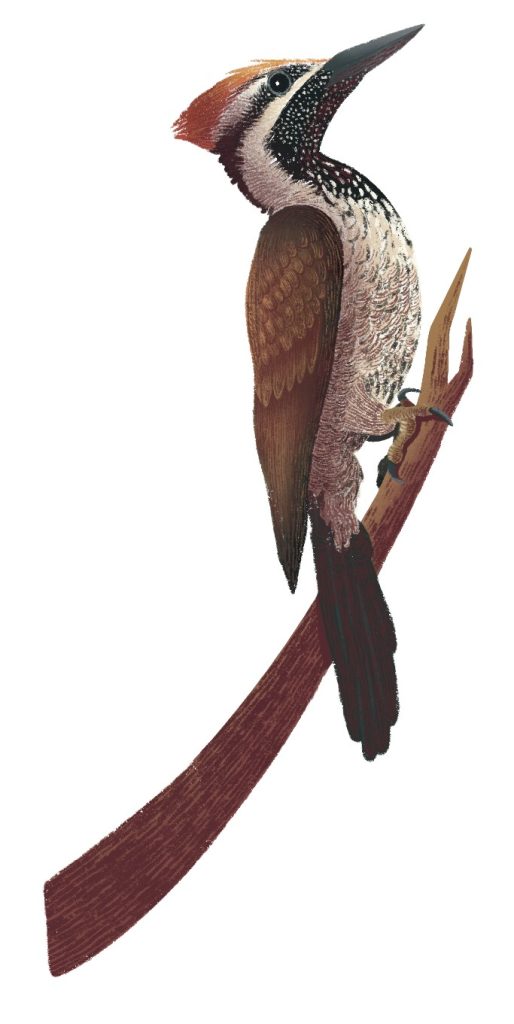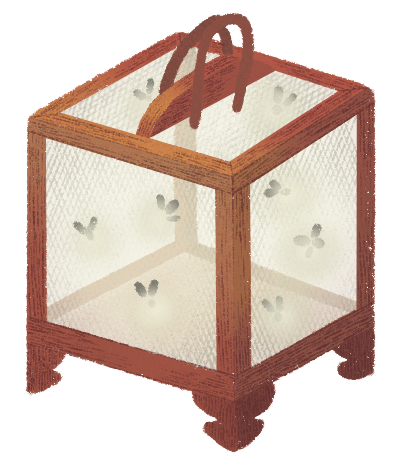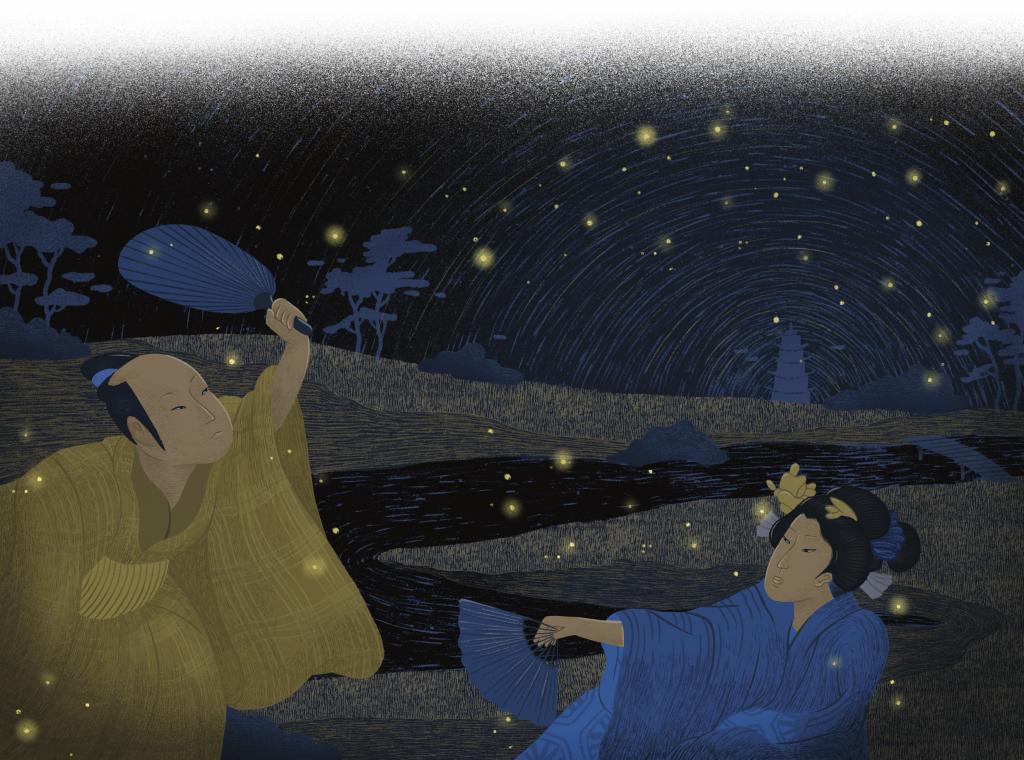Fireflies are common insects in both temperate and tropical ecosystems. They feed on garden pests such as snails and slugs. Contrary to what their name suggests, fireflies are not flies—they are beetles. To be precise, they are bioluminescent beetles, i.e., insects that can produce light through biochemical reactions in their bodies. The human fascination with fireflies is embedded in many cultures and places around the world, and maybe it stems partly from some ancient envy, that insects should have learned to light a fire before we did. In this column, I showcase the importance of fireflies in two different archipelagic cultures: the first is from the Andaman Islands (India) and the second is from Japan.
The waye-dama
The Ang people (earlier known as the Jarawa) of the Andaman Islands consider fireflies to be the earthly equivalents of stars—both are called waye-dama. They believe that while the twinkling of the stars maintains cosmic rhythms such as the durations of day and night, the twinkling of the fireflies synchronises the rhythms of the forest with the sky, especially the play of heat and light. A retelling of an Ang tale describes the significance of fireflies in their culture:

One night, deep inside the forest, an Ang ancestor could not sleep and felt disturbed by the glow of waye-dama all around him. In a fit of temper, he broke off the branches on which the waye-dama were resting and threw it into the cold water in which the mangroves stood. As he fell asleep, the waye-dama began dying in the cold mangrove water and their body heat leached out. It turned the shells of the mangrove crabs red with heat, leaving them too tired to climb out of their tidal pools. (That is why to this day, mangrove crabs have to wait until the full moon has cooled down the forest before they can emerge from the water and lay their eggs.)
Eventually, the ancestor woke up and began to stumble around because it was too dark to see without any waye-dama in the forest. As he tried to find his way, he fell over two strange things on his path—an empty Ang stomach and a tuberous root. As soon as they recognised him, the stomach and the root began complaining loudly. They ordered him to take them along with him, in the comfort of his beautifully woven basket. But once inside the basket, their complaints did not cease. Now, the stomach wanted to be kept inside his body and the root wanted to be cocooned inside the stomach. But both the stomach and the root were rigid with cold and the Ang did not know how to fit them all inside his body. Seeking guidance, he consulted the woodpeckers, who knew how to work with hard objects.

The woodpeckers took pity on the confused Ang and taught him how to extract resin and make a smouldering fire that would warm up his body. They told him that once his body was warm, he would be able to fit the stomach inside. He followed the woodpeckers’ instructions but was left with the problem of what to do with the root. Next the resin came to his rescue—it told the Ang to dip his fingers and toes in the mangrove water and seek the forgiveness of the waye-dama. When the Ang did so, the body heat of the crabs, which was essentially the fire of the waye-dama, flowed into his body and he was able to kindle a cooking fire to warm up the root and put it into his stomach. Ever since that day, the Ang people have respected the waye-dama for teaching them how to maintain the glow of life.
The hotaru
In Japanese culture too, fireflies or hotaru occupy a prominent position—many works of art depict people capturing, playing with, or simply admiring fireflies. In literature, hotaru represent the transience of life as well as intense love. The famous poet Kobayashi Issa is said to have written 230 haikus in the 18th century, all on fireflies, including:
A giant firefly:
that way, this way, that way, this –
and it passes by.

A tragic Japanese short story titled Hotaru no haka by Akuyuki Nosaka uses the symbolism of fireflies to describe real-life events around the bombing of Kobe, which was an important Japanese port, during World War II. The animé version of this story is well-known to English speakers as the poignant “Grave of the fireflies”. Until World War II, there were even bands of professional firefly catchers, who used mosquito netting to capture masses of fireflies and sold them in gauze-covered boxes to customers in large cities such as Osaka. There were shops and pushcarts as well, called mushiya, that specialised in the sale of different kinds of insects, such as singing crickets, jewel beetles, and of course, fireflies. Several Japanese traditional songs that are still sung today refer to fireflies:
Ho ho hotaru koi
Atchi no mizu wa nigai zo
Kotchi no mizu wa amai zo
Ho ho hotaru koi
Ho ho firefly, come
The water there is bitter
The water here is sweet
Ho ho firefly, come
Firefly tourism
In current times, nature tourism often replaces the deeper connection that nature worship fostered in earlier periods. In the case of fireflies, there is an entire network of locations that tourists visit for the sole purpose of viewing and admiring firefly aggregations. Firefly tourism, as it is called, attracts over one million tourists each year to over 12 countries—such as Mexico, United Kingdom, Croatia, Thailand and Japan—scattered across three continents (North America, Europe and Asia). Imagine a biochemical reaction in an insect driving such largescale movement of people! But what exactly is this intriguing phenomenon?

In fireflies, bioluminescence is caused when a compound called luciferin gets oxidised in the presence of an enzyme called luciferase. This reaction releases energy in the form of green or yellow light that makes the firefly’s abdomen glow. This glow is called “cold light” because it has neither ultraviolet nor infrared components. Amongst the 2000-odd species of fireflies, bioluminescence serves one or both of the following purposes: It helps the males and females of a species find each other during the breeding season, because the colour and pattern of the light pulses are often species-specific. It may also serve to warn predators that certain species of fireflies are toxic and keep the latter safe from predation.
However, fireflies are increasingly threatened by pesticide use and artificial illumination, because they are sensitive to chemicals and light. Therefore, well-run tourism packages will often insist on firefly-watching etiquette such as avoiding the use of perfumes or flash photography in their vicinity. The next time you see pulses of light in your garden or on a bush by the roadside, I hope you will take a minute to admire these luminous insects.
Further Readings
Pandya, V. 2016. In pursuit of fireflies: the poetics and politics of ‘lightscapes’ in Jarawa forests. In: New histories of the Andaman Islands – Landscape, place and identity in the Bay of Bengal, 1790-2012. (eds. Anderson, C., M. Mazumdar and V. Pandya). Pp 201–228. Cambridge: Cambridge University Press.
Lewis, S. M., A. Thancharoen, C. H. Wong, T. López- Palafox, P. V. Santos, C. Wu, L. Faust et al. 2020. Firefly tourism: Advancing a global phenomenon toward a brighter future. Conservation science and practice 3(5): e391: https://doi.org/10.1111/csp2.391.






